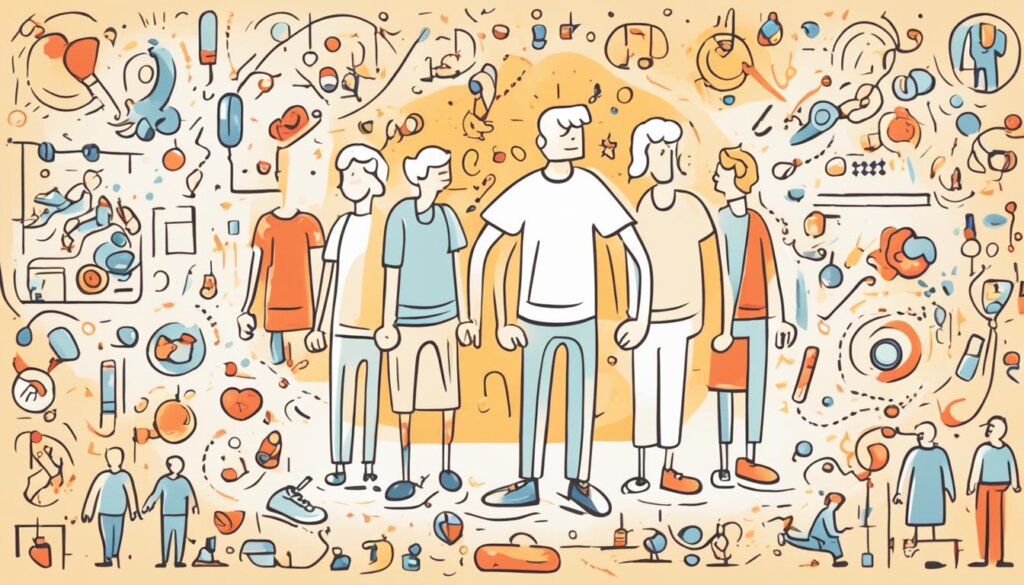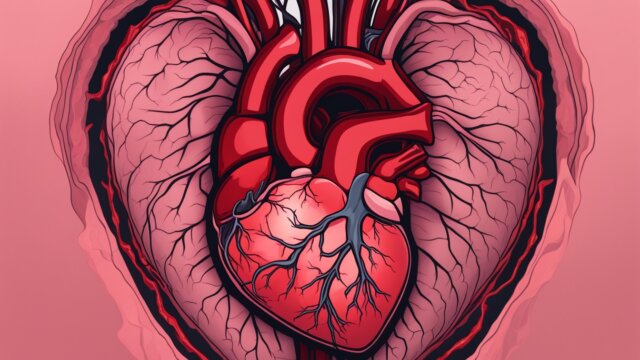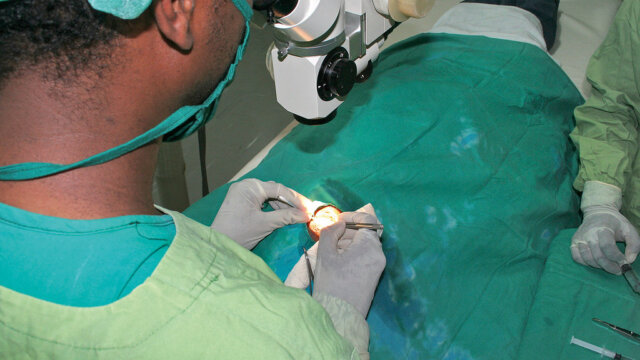FTC disclaimer: This post may contains affiliate links and we will be compensated if you click on a link and make a purchase.
About 1 in 10 people in the U.S. have type 2 diabetes, making it the most common type. This shows how big the health issue is. It’s important to know about type 2 diabetes to manage and prevent it.
Type 2 diabetes makes it hard for the body to use sugar for fuel. This happens because the body’s cells don’t respond well to insulin, and insulin production is low. If not managed, it can cause serious health problems.
Key Takeaways
- Type 2 diabetes is the most common form of diabetes, affecting 1 in 10 people in the U.S.
- Risk factors include being overweight or obese, having a family history, certain ethnicities, and lifestyle factors like inactivity and poor sleep.
- Complications of uncontrolled type 2 diabetes can include heart disease, nerve damage, kidney disease, and vision problems.
- Lifestyle changes like a healthy diet and regular exercise, along with medication management, are crucial for managing type 2 diabetes.
- Early detection and prevention through lifestyle modifications can help reduce the risk of developing type 2 diabetes.
Understanding Type 2 Diabetes
What is Type 2 Diabetes?
Type 2 diabetes is a condition where the body’s cells don’t respond well to insulin. This hormone helps control blood sugar levels. So, there’s more glucose in the blood, causing high sugar levels. The pancreas might also not make enough insulin. This type of diabetes is very common and can start slowly over years, often without any symptoms at first.
How Insulin Works in the Body
Insulin is key for getting glucose into cells for energy. But in type 2 diabetes, this process breaks down. This leads to insulin resistance and less insulin from the pancreas. These issues are major factors in getting type 2 diabetes.
“Insulin resistance, where the body’s cells become less responsive to insulin, and impaired pancreatic insulin production are key factors in the progression of type 2 diabetes.”
Lifestyle choices and genes can lead to type 2 diabetes. Factors include being overweight, not moving much, and eating poorly. Knowing how insulin and glucose work is key to managing and preventing type 2 diabetes.
Symptoms of Type 2 Diabetes
Type 2 diabetes often starts slowly and its signs might be mild. This makes it hard to notice for years. It’s key to know the common signs to catch it early. These signs include feeling very thirsty, needing to pee a lot, feeling hungry all the time, losing weight without trying, feeling tired, seeing blurry, having slow-healing cuts, and getting more infections.
People with type 2 diabetes might also feel numbness or tingling in their hands or feet. They might see dark skin in places like the armpits and neck. These signs can be mild or not easy to spot. So, watch your body closely and see a doctor if you think you might have type 2 diabetes.
- Increased thirst
- Frequent urination
- Heightened hunger
- Unintended weight loss
- Fatigue
- Blurred vision
- Slow-healing sores
- Frequent infections
- Numbness or tingling in hands/feet
- Darkened areas of skin
About 1 in 4 people with type 2 diabetes don’t know they have it. Finding it early and managing it well is key. This helps prevent serious problems like heart disease, nerve damage, and kidney issues.
If you or someone you know has these symptoms, see a doctor right away. Early action and a good plan can help manage type 2 diabetes. This keeps you healthy overall.

“Recognizing the early signs of type 2 diabetes is the first step towards taking control of your health and well-being.”
Causes and Risk Factors
The main causes of type 2 diabetes are insulin resistance and impaired pancreatic function. Insulin resistance means the body’s cells don’t respond well to insulin. This leads to more glucose in the blood. The pancreas makes more insulin to try to fix this, but it can’t keep up over time.
Insulin Resistance and Pancreatic Issues
Being overweight or obese, not moving much, and eating poorly can make insulin resistance worse. Your genes and your race or ethnicity can also make you more likely to get type 2 diabetes.
Lifestyle and Genetic Risk Factors
- Adults with a BMI of 25 or higher are considered overweight and have a higher risk of developing type 2 diabetes.
- Asian Americans are considered overweight if their BMI is 23 or higher, while Pacific Islanders are considered overweight with a BMI of 26 or higher.
- Men have a higher risk of developing diabetes if their waist circumference exceeds 40 inches, while non-pregnant women have a higher risk with a waist circumference above 35 inches.
- Waist circumference serves as an indirect measurement of abdominal fat, which is a risk factor for diabetes and heart disease even with a normal BMI.
- Lifestyle interventions or metformin can lead to a reduction in the incidence of type 2 diabetes according to The New England Journal of Medicine.
- Individuals with overweight or obesity are at increased risk for both prediabetes and type 2 diabetes.
- Being aged 45 or older is a risk factor for developing prediabetes and type 2 diabetes.
- Family history of type 2 diabetes increases the likelihood of developing prediabetes and type 2 diabetes.
- African Americans, Hispanic or Latino individuals, American Indians, Alaska Natives, Pacific Islanders, and Asian Americans have a higher risk of developing prediabetes and type 2 diabetes.
- Obesity and an inactive lifestyle account for about 90% to 95% of diabetes cases in the United States.
- Type 2 diabetes is more prevalent among African Americans, Native Americans, Hispanic Americans, and Asian Americans compared to non-Hispanic whites.
- Over 45 years of age significantly increases the risk of type 2 diabetes, with a considerable rise after age 65.
- Research shows that obesity is a primary reason for type 2 diabetes, affecting more teenagers due to the increase in obesity among U.S. children.
- Sedentary lifestyles, exercising fewer than three times a week, are linked to an increased risk of type 2 diabetes.
- Having a family history of diabetes, such as a parent or sibling with the condition, increases the likelihood of developing type 2 diabetes.
The combination of risk factors like age, family history, race, obesity, physical inactivity, and other conditions can affect your chance of getting type 2 diabetes.

Diagnosing Type 2 Diabetes
Diagnosing type 2 diabetes means checking your blood sugar levels with blood tests. These tests help tell if you have diabetes, prediabetes, or normal blood sugar. The A1C test, fasting plasma glucose test, and oral glucose tolerance test are the main tests used.
Blood Tests for Diabetes
The A1C test looks at your average blood sugar over 2-3 months. If it’s 6.5% or higher, you likely have diabetes. Levels between 5.7% and 6.4% mean you’re at risk, and below 5.7% is normal.
The fasting plasma glucose test checks your blood sugar after an 8-hour fast. A reading of 126 mg/dL or more means diabetes. Levels between 100-125 mg/dL suggest prediabetes and less than 100 mg/dL is normal.
The oral glucose tolerance test (OGTT) checks your blood sugar before and 2 hours after a sugary drink. A 2-hour reading of 200 mg/dL or higher means diabetes. Levels between 140-199 mg/dL suggest prediabetes, and less than 140 mg/dL is normal.

Sometimes, a random plasma glucose test is used. This test checks your blood sugar at any time. A reading of 200 mg/dL or higher means diabetes, no matter when you last ate.
If your doctor thinks you might have type 2 diabetes, they’ll suggest one or more tests. Catching it early and treating it is key to managing it and avoiding problems.
Stages of Type 2 Diabetes
The progression of type 2 diabetes has four main stages. The first stage is insulin resistance, where the body’s cells don’t respond well to insulin. But, blood sugar levels are still normal.
The second stage is prediabetes, where blood sugar levels are higher than normal but not high enough to be diabetes. This stage is more common in certain groups like African Americans and Hispanics/Latinos.
The third stage is type 2 diabetes, where blood sugar levels stay high. Normal fasting blood sugar is 99 mg/dL or lower. Prediabetes levels are between 100 to 125 mg/dL. Levels of 126 mg/dL or higher mean you have type 2 diabetes.
The final stage is type 2 diabetes with vascular complications. This happens when high blood sugar damages blood vessels. It can affect the eyes, kidneys, nerves, and heart.
Lifestyle changes like healthy eating and exercise can stop prediabetes from turning into type 2 diabetes. People with type 2 diabetes can live about 63 years if they manage their diabetes well. Older adults find it harder to manage diabetes because of frailty and cognitive changes.

In summary, type 2 diabetes has stages from insulin resistance to vascular complications. Early action and good management can stop or slow the disease’s progress.
Managing Type 2 Diabetes
Lifestyle Changes for Diabetes Management
Managing type 2 diabetes often means making lifestyle changes and sometimes taking medicine. Lifestyle changes, like losing weight, eating healthy, and moving more, are.
Eating foods high in fiber and controlling how much you eat can make your body better at using insulin. Also, doing exercises like walking, swimming, or lifting weights can help lower your blood sugar and boost your health. Checking your blood sugar often is also important for managing your diabetes well.
Type 2 diabetes happens when your body can’t use and store glucose well, raising your blood sugar levels. Being overweight or having belly fat can make your body need more insulin, making diabetes worse if not fixed. It’s important to keep treating and managing your diabetes to keep your blood sugar in check and avoid serious problems.
Lifestyle Factor | Impact on Type 2 Diabetes Management |
|---|---|
Weight Loss | Can improve insulin sensitivity and reduce the need for medication |
Healthy Eating | Focusing on whole, fiber-rich foods can help regulate blood sugar levels |
Physical Activity | Regular exercise can lower blood sugar and enhance overall health |
Blood Sugar Monitoring | Tracking blood sugar levels is crucial for effective management |
By making lifestyle changes and possibly taking medicine, people with type 2 diabetes can manage their condition better. This can lower the risk of serious problems and improve their health.
“Lifestyle changes, such as weight loss, healthy eating, and regular physical activity, can be instrumental in controlling blood sugar levels and reducing the risk of complications.”
Medications for Type 2 Diabetes
If lifestyle changes alone don’t control blood sugar, doctors may suggest medications for type 2 diabetes. These include metformin, which lowers glucose production in the liver and helps the body use insulin better.
There are also sulfonylureas and meglitinides, which make the pancreas produce more insulin. Thiazolidinediones improve how well insulin works. DPP-4 inhibitors boost the body’s natural insulin hormones. GLP-1 agonists slow down digestion and lower blood sugar. And SGLT2 inhibitors help the kidneys get rid of extra glucose.
Medication Class | Examples | Mechanism of Action | Potential Side Effects |
|---|---|---|---|
Biguanides | Metformin | Reduces liver glucose production, improves insulin sensitivity | Nausea, stomach pain, diarrhea |
Sulfonylureas | Glipizide, Glimepiride, Glyburide | Stimulate pancreas to produce more insulin | Weight gain, skin rash, hypoglycemia |
Meglitinides | Repaglinide, Nateglinide | Stimulate pancreas to produce more insulin | Hypoglycemia, weight gain |
Thiazolidinediones (TZDs) | Pioglitazone | Improve insulin sensitivity | Weight gain, fluid retention, heart problems |
DPP-4 Inhibitors | Alogliptin, Linagliptin, Saxagliptin, Sitagliptin | Enhance natural insulin-regulating hormones | Upper respiratory tract infection, sore throat, headache |
GLP-1 Agonists | Dulaglutide, Exenatide, Liraglutide, Lixisenatide, Semaglutide | Slow digestion, lower blood sugar levels | Nausea, vomiting, diarrhea, abdominal pain, pancreatitis |
SGLT2 Inhibitors | Canagliflozin, Dapagliflozin, Empagliflozin, Ertugliflozin | Remove excess glucose through urine | Urinary tract infections, yeast infections |
Bile Acid Sequestrants | Colesevelam | Lower cholesterol, reduce blood glucose | Gas, constipation, indigestion, increased triglycerides |
Amylin Mimetics | Pramlintide | Regulate blood sugar, slow food moving through stomach | Low blood sugar, nausea, abdominal pain |
The right medication or mix of medications depends on what the person needs and how they react to treatment.
“Medications can be an important part of managing type 2 diabetes, but they should be used in conjunction with lifestyle changes to achieve the best outcomes.”
Complications of Uncontrolled Diabetes
If you don’t manage your type 2 diabetes, it can lead to serious health issues. These issues include heart disease, nerve damage, kidney disease, and eye damage. It’s important to manage your diabetes to avoid these problems.
Cardiovascular and Nerve Damage
High blood sugar from uncontrolled diabetes can harm your blood vessels. This increases your risk of heart disease, stroke, and atherosclerosis. People with diabetes are twice as likely to have heart problems and strokes.
It can also cause nerve damage or neuropathy. This leads to tingling, numbness, and pain in your hands and feet. It can also affect your digestive system, heart, and sexual function.
Kidney Disease and Eye Damage
Diabetes is the main cause of kidney failure in adults in the U.S., making up almost half of new cases. It can also harm your eyes, causing cataracts, glaucoma, and diabetic retinopathy. These can lead to vision loss.
However, regular eye exams and early treatment can prevent up to 90% of diabetes-related blindness.
To prevent and manage these issues, you need a full plan. Keep your blood sugar levels healthy, exercise, eat well, and follow your doctor’s advice. Taking care of your health can lower the risk of these serious problems.
“Keeping blood sugar under control, a healthy diet, exercise, weight management, smoking cessation, and proper management of high blood pressure and high cholesterol are essential to slow down diabetes complications.”
Type 2 Diabetes Prevention
Living a healthy life can help prevent type 2 diabetes. It’s important to keep a healthy weight by eating well and staying active. This can greatly lower your risk of getting this disease.
Healthy Lifestyle for Diabetes Prevention
Eat lots of fruits, veggies, whole grains, and lean meats. Also, do exercises like walking, swimming, or lifting weights. This can make your body more sensitive to insulin and lower your diabetes risk.
One big study showed that losing about 7% of your weight through diet and exercise can cut your diabetes risk by almost 60%. The American Diabetes Association says losing 7% to 10% of your weight can stop diabetes from getting worse.
Exercise is key to preventing diabetes. Adults should do at least 150 minutes of moderate to hard exercise each week. Studies show losing 5 to 7 percent of your weight can stop or slow type 2 diabetes.
If you have prediabetes, losing weight and changing your lifestyle can help stop diabetes from happening. Sometimes, doctors might also suggest taking metformin to lower your risk.
Choosing healthy foods and staying active can really help prevent type 2 diabetes. It’s important to keep these habits for life, focusing on losing weight and keeping it off. The FDA and the 2020-2025 Dietary Guidelines for Americans offer great advice on eating right to stay healthy and avoid chronic diseases like diabetes.
“Healthy lifestyle changes can make a big difference in lowering your risk of type 2 diabetes. By eating well and exercising regularly, you can take steps to prevent this condition and improve your health.”
Epidemiology of Type 2 Diabetes
Type 2 diabetes is a big health issue worldwide. It affects about 462 million people, or 6.3% of the world’s population. It’s getting more common, especially in places like the U.S. and Western Europe. Both men and women get it, but it’s more common in people over 50, affecting 15% of those aged 50-69 and 22% of those 70 and older.
Some groups like African Americans, Hispanics, Native Americans, Asian Americans, and Pacific Islanders are at higher risk. In the U.S., 14.7% of adults over 18 have diabetes, with different rates for different groups.
The number of people with type 2 diabetes is expected to keep going up, reaching 7079 cases per 100,000 by 2030. This is especially worrying for poorer countries, where diabetes is getting worse fast.
Region | Prevalence Rate (per 100,000) |
|---|---|
Global | 6059 |
Western Europe | 8529 |
United States | 8911 |
Africa | 3916 |
Diabetes and its problems, like kidney disease, are a big health issue, causing about 2 million deaths in 2019. But, there’s good news. The chance of dying from certain diseases between 30 and 70 has dropped by 22% from 2000 to 2019.
Conclusion
Type 2 diabetes is a long-term condition that needs careful management. It helps control blood sugar levels and prevents serious problems. Research shows that in 2021, over 400 million adults had diabetes. Type 2 diabetes makes up more than 90% of all diabetes cases.
Changing your lifestyle, like losing weight, eating healthy, and exercising, can help manage type 2 diabetes. Sometimes, you might need to take medicine too. Studies say being overweight, having diabetes in your family, and not moving much can increase your risk.
By managing your diabetes well, you can live a healthier life. The world faces a big challenge with type 2 diabetes, but how common it is varies by country. Thanks to new treatments and a focus on prevention, the future looks good for people with type 2 diabetes. By learning and managing your diabetes, you can improve your health and look forward to a better future.
FAQ
What is type 2 diabetes?
Type 2 diabetes is a condition where the body can’t use sugar right. It happens when the body doesn’t make enough insulin or can’t use insulin well. This leads to high blood sugar levels.
What are the symptoms of type 2 diabetes?
Symptoms include feeling very thirsty, needing to pee a lot, feeling hungry, losing weight without trying, feeling tired, blurry vision, slow healing of cuts, and getting more infections. Some may also feel numbness or tingling in their hands or feet, and see dark skin in certain areas.
What causes type 2 diabetes?
It’s mainly caused by not using insulin well and not making enough insulin. Being overweight, not moving much, and eating poorly can make it worse. Your genes and race can also increase your risk.
How is type 2 diabetes diagnosed?
Doctors use blood tests like the A1C, fasting plasma glucose, and oral glucose tolerance test to find type 2 diabetes. A score of 6.5% or higher on the A1C test means you have diabetes.
What are the stages of type 2 diabetes?
Type 2 diabetes goes through four stages: insulin resistance, prediabetes, diabetes, and diabetes with complications.
How is type 2 diabetes managed?
Managing it means changing your lifestyle and possibly taking medicine. Eating right, losing weight, and exercising can help control blood sugar. If needed, doctors may prescribe medicine to help.
What are the potential complications of uncontrolled type 2 diabetes?
Without control, it can cause serious problems like heart disease, nerve damage, kidney disease, and eye damage.
How can type 2 diabetes be prevented?
A healthy lifestyle can prevent it. Eating well and staying active can lower your risk. If you have prediabetes, losing weight and changing your habits can stop or slow it down.
What is the global prevalence of type 2 diabetes?
It affects about 462 million people worldwide or 6.3% of the world’s population. It’s getting more common, especially in places like the U.S. and Western Europe.








